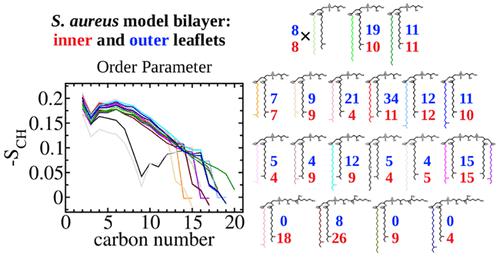Our official English website, www.x-mol.net, welcomes your
feedback! (Note: you will need to create a separate account there.)
Generation and Computational Characterization of a Complex Staphylococcus aureus Lipid Bilayer
Langmuir ( IF 3.7 ) Pub Date : 2022-07-28 , DOI: 10.1021/acs.langmuir.2c00483 Faramarz Joodaki 1 , Lenore M Martin 2 , Michael L Greenfield 1
Langmuir ( IF 3.7 ) Pub Date : 2022-07-28 , DOI: 10.1021/acs.langmuir.2c00483 Faramarz Joodaki 1 , Lenore M Martin 2 , Michael L Greenfield 1
Affiliation

|
Studies indicate a crucial cell membrane role in the antibiotic resistance of Staphylococcus aureus. To simulate its membrane structure and dynamics, a complex molecular-scale computational representation of the S. aureus lipid bilayer was developed. Phospholipid types and their amounts were optimized by reverse Monte Carlo to represent characterization data from the literature, leading to 19 different phospholipid types that combine three headgroups [phosphatidylglycerol, lysyl-phosphatidylglycerol (LPG), and cardiolipin] and 10 tails, including iso- and anteiso-branched saturated chains. The averaged lipid bilayer thickness was 36.7 Å, and area per headgroup was 67.8 Å2. Phosphorus and nitrogen density profiles showed that LPG headgroups tended to be bent and oriented more parallel to the bilayer plane. The water density profile showed that small amounts reached the membrane center. Carbon density profiles indicated hydrophobic interactions for all lipids in the middle of the bilayer. Bond vector order parameters along each tail demonstrated different C–H ordering even within distinct lipids of the same type; however, all tails followed similar trends in average order parameter. These complex simulations further revealed bilayer insights beyond those attainable with monodisperse, unbranched lipids. Longer tails often extended into the opposite leaflet. Carbon at and beyond a branch showed significantly decreased ordering compared to carbon in unbranched tails; this feature arose in every branched lipid. Diverse tail lengths distributed these disordered methyl groups throughout the middle third of the bilayer. Distributions in mobility and ordering reveal diverse properties that cannot be obtained with monodisperse lipids.
中文翻译:

复杂金黄色葡萄球菌脂质双层的生成和计算表征
研究表明,细胞膜在金黄色葡萄球菌的抗生素耐药性中起着至关重要的作用。为了模拟其膜结构和动力学,开发了金黄色葡萄球菌脂质双层的复杂分子尺度计算表示。磷脂类型及其数量通过反向蒙特卡罗优化以代表文献中的表征数据,产生了 19 种不同的磷脂类型,它们结合了三个头基 [磷脂酰甘油、赖氨酰-磷脂酰甘油 (LPG) 和心磷脂] 和 10 个尾巴,包括异-和反异支化饱和链。平均脂质双层厚度为 36.7 Å,每个头部组的面积为 67.8 Å 2. 磷和氮的密度分布表明 LPG 头基倾向于弯曲并且更平行于双层平面。水密度分布显示少量到达膜中心。碳密度分布表明双层中间所有脂质的疏水相互作用。即使在相同类型的不同脂质中,沿每条尾巴的键向量顺序参数也显示出不同的 C-H 顺序;然而,所有尾部在平均订单参数上都遵循相似的趋势。这些复杂的模拟进一步揭示了超越单分散、无支链脂质所能达到的双层洞察力。较长的尾巴通常延伸到对面的小叶中。与未分支尾部中的碳相比,分支处和分支之外的碳显示出显着降低的排序;这个特征出现在每一个分支的脂质中。不同的尾长将这些无序的甲基分布在双层的中间三分之一处。流动性和有序性的分布揭示了单分散脂质无法获得的多种特性。
更新日期:2022-07-28
中文翻译:

复杂金黄色葡萄球菌脂质双层的生成和计算表征
研究表明,细胞膜在金黄色葡萄球菌的抗生素耐药性中起着至关重要的作用。为了模拟其膜结构和动力学,开发了金黄色葡萄球菌脂质双层的复杂分子尺度计算表示。磷脂类型及其数量通过反向蒙特卡罗优化以代表文献中的表征数据,产生了 19 种不同的磷脂类型,它们结合了三个头基 [磷脂酰甘油、赖氨酰-磷脂酰甘油 (LPG) 和心磷脂] 和 10 个尾巴,包括异-和反异支化饱和链。平均脂质双层厚度为 36.7 Å,每个头部组的面积为 67.8 Å 2. 磷和氮的密度分布表明 LPG 头基倾向于弯曲并且更平行于双层平面。水密度分布显示少量到达膜中心。碳密度分布表明双层中间所有脂质的疏水相互作用。即使在相同类型的不同脂质中,沿每条尾巴的键向量顺序参数也显示出不同的 C-H 顺序;然而,所有尾部在平均订单参数上都遵循相似的趋势。这些复杂的模拟进一步揭示了超越单分散、无支链脂质所能达到的双层洞察力。较长的尾巴通常延伸到对面的小叶中。与未分支尾部中的碳相比,分支处和分支之外的碳显示出显着降低的排序;这个特征出现在每一个分支的脂质中。不同的尾长将这些无序的甲基分布在双层的中间三分之一处。流动性和有序性的分布揭示了单分散脂质无法获得的多种特性。











































 京公网安备 11010802027423号
京公网安备 11010802027423号